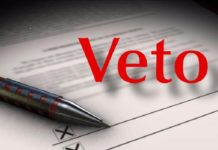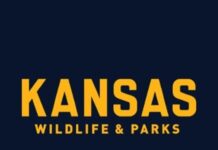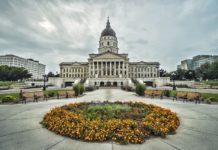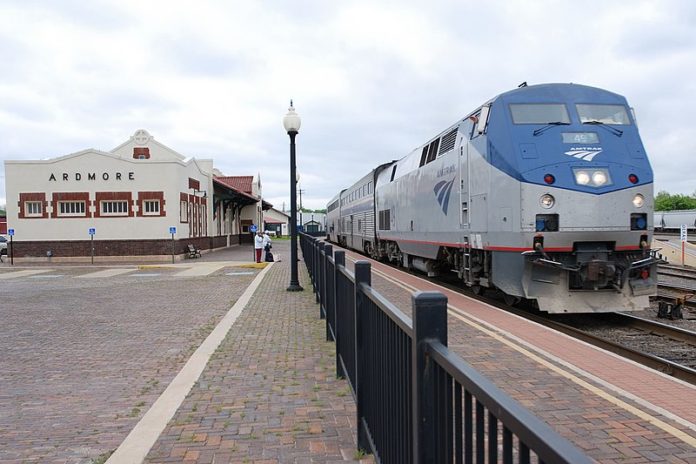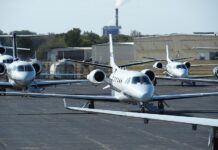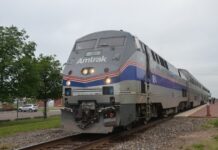(Updated to include comment from state senator who chaired the Midwest Interstate Passenger Rail Commission and the governor)
Kansas took a significant step toward reviving passenger rail service connecting Wichita and Newton to Oklahoma City when it was awarded a federal grant of up to $500,000 for planning a route that was ended more than 40 years ago.
The Federal Railroad Administration on Friday morning announced that Kansas was among the 69 rail corridors it picked in 44 states for planning passenger rail service expansion.
The money would go toward the proposed Heartland Flyer extension, which would bring passenger rail service north into Kansas from Oklahoma City, where it already runs to Fort Worth with connections to Dallas and San Antonio on Amtrak’s Texas Eagle.
The FRA also awarded a similar grant for up to $500,000 for Missouri to study a proposed rail corridor connecting St. Joseph to Kansas City, Missouri, including a connection to the existing state-supported Missouri River Runner route to St. Louis.
“I certainly think it’s promising or they wouldn’t be giving us the half-million dollars to move forward,” Republican state Sen. Carolyn McGinn said of the long-term prospect for the passenger rail extension.
“It’s nice to see after working on this over a dozen years that it looks like there’s a possible light at the end of the tunnel that might be barely shining,” said McGinn, who recently chaired the Midwest Interstate Passenger Rail Commission.
“It also means that with that there’s going to be increased responsibility and working even harder to finish this,” McGinn said in an interview.
This FRA’s inaugural round of selections seeks to upgrade 15 existing rail routes, add or extend service on 47 new routes, and advance seven new high-speed rail projects.
The agency’s goal is to create a pipeline of intercity passenger rail projects ready for implementation and future investment.
“Today’s announcement is another step forward as we advance transformative projects that will carry Americans for decades to come and provide them with convenient, climate-friendly alternatives to congested roads and airports,” FRA Administrator Amit Bose said in a statement announcing the grant.
“We’re thinking about the future too with comprehensive and systematic planning efforts to transform the U.S. intercity passenger rail network now and in the years to come,” Bose said.

The Heartland Flyer service would run from Oklahoma City north into Wichita and Newton with stops in Edmond; Guthrie; Perry; Ponca City, Oklahoma; and Arkansas City, Kansas.
There are an estimated 1.2 million people who live in the markets that would be served by the extension of the Heartland Flyer.
“The extension of the Heartland Flyer Passenger Rail would further connect Kansans to Oklahoma City and north central Texas, unlocking business, educational, and cultural opportunities to Kansans and enabling our neighbors to the south to add to the Kansas economy,” Gov. Laura Kelly said in a statement.
“One of Kansas’ greatest assets is that we are in the center of the country, which is why my administration has supported rail projects like this to build on that strength.”
The new federal money would go toward developing a scope, schedule and cost estimate for preparing, completing or documenting the service development plan for the project.
The awarding of the grant is significant because it opens the door for Kansas to qualify for other federal money that would pay for the project in different stages, including environmental, engineering and design work as well as the early years of operating costs.
The federal government has $1.8 billion allocated for new rail corridor planning in the next five years.
It is part of the $550 billion in new infrastructure spending that Congress approved two years ago and that the president signed into law.
The infrastructure bill provided $66 billion for capital investment and passenger rail over five years.
The 206-mile Heartland Flyer extension is now estimated – in 2020 dollars – at about $124.4 million. It was originally estimated at about $400 million.
The reduced cost reflects that some of the improvements that need to be made to existing track in the freight corridor will be bankrolled by BNSF Railway.
The estimate includes $15.8 million in capital expenditures in Kansas and $79.8 million in Oklahoma, according to the application submitted to the federal railroad agency.
There is another $28.8 million planned for safety measures in the corridor to prevent train collisions and derailments.
Any money for operating costs, which were estimated in 2011 to be $7.4 million a year, would likely start with 100% federal funding.
But that money would be ratcheted down until the state would assume those costs after five years, state officials have told lawmakers.
The proposed extension of the Heartland Flyer from Oklahoma City to Newton, Kansas is part of Amtrak’s 15-year, $75 billion plan to add 39 new rail routes and expand service on 25 others across the country.
Passenger rail service from Newton to Oklahoma City was ended in 1979 when Amtrak’s Chicago-Dallas-Houston service was discontinued.
The existing Heartland Flyer from Oklahoma City to Fort Worth was revived in 1999.
An extension from Oklahoma City to Newton would link to the Southwest Chief, a cross-country route that connects to Topeka, Lawrence, Kansas City and Chicago to the east and Los Angeles to the west.
The Heartland Flyer project has widespread support in Kansas and the backing of Republican U.S. Sens. Roger Marshall and Jerry Moran as well as Democratic U.S. Rep. Sharice Davids and Republican U.S. Rep. Ron Estes.
“The long-awaited full reconnection of this corridor would provide increased transportation choices, reduce congestion, and enhance economic opportunity for rural and urban residents and businesses alike,” they wrote in a letter to U.S. Transportation Secretary Pete Buttigieg last February.
“With its long-term value of boosting economic growth within the booming I-35 corridor megaregion and its near-term benefit of improving the Amtrak national system, acceptance into the corridor ID program is the first step in this vital 400-mile reconnection.”


